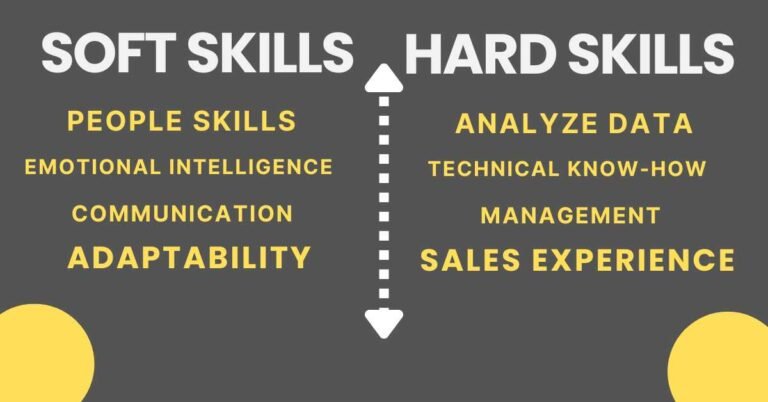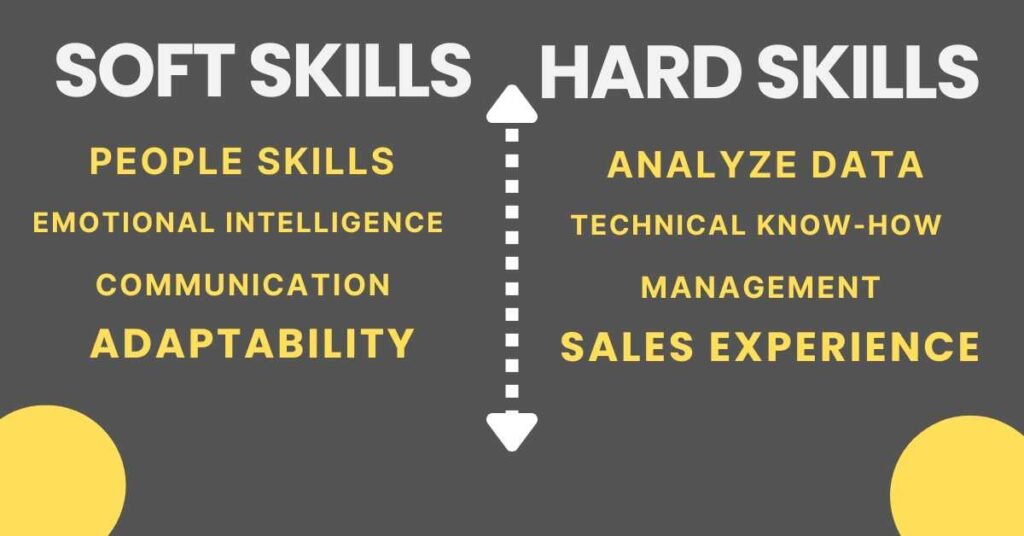
1. Introduction
The argument over soft skills vs hard skills, or which of the two is superior, has become popular in today’s dynamic workplace. The question that often lingers in our minds is this: Should we consider soft skills as superseding hard skills, or is balance the optimal approach? However, to shed more light on this issue, we will set off on an exploration of the meaning of soft and hard skills and the role they play in careers and friendships.

2. Soft Skills and Hard Skills
For us to understand this debate, we must first specify the main characters who will be involved in it. Soft skills, also known as interpersonal or people skills, are the qualities that make people work together in harmony. This entails the likes of empathy, communication, adaptability, and emotional intelligence. The second type of skill is referred to as hard skills, and these are the specific tangible, teachable skills associated with the job or industry. Imagine hard skills as the technical know-how and expertise behind doing things rightfully—for example, the ability to code, analyze data, or do surgery.
3. The Importance of Hard Skills
In certain domains, hard skills are the bread and butter of professional success. Industries such as engineering, medicine, and information technology demand a profound mastery of specific techniques and knowledge. These hard skills are often non-negotiable and form the very foundation of competence. For example, a software developer must possess the technical skills to code software applications successfully. Without these hard skills, the developer’s ability to contribute significantly to the field would be limited.
Examples of Hard Skills:
- Programming and Coding: Proficiency in programming languages such as Python, Java, C++, or JavaScript.
- Data Analysis: The ability to gather, interpret, and analyze data using tools like Excel, SQL, or data visualization software.
- Digital Marketing: Knowledge of online marketing strategies, including SEO, SEM, social media advertising, and email marketing.
- Graphic Design: Proficiency in design software like Adobe Photoshop, Illustrator, or InDesign.
- Financial Analysis: The ability to assess financial data, create budgets, and analyze financial reports.
- Project Management: Skills in planning, executing, and managing projects, often using project management software like Microsoft Project.
- Database Management: Proficiency in handling and maintaining databases, using software like Oracle, MySQL, or Microsoft SQL Server.
- Content Writing: Writing and editing content for various purposes, such as web content, technical documentation, or marketing materials.
- Search Engine Optimization (SEO): Knowledge of optimizing websites for search engines to improve online visibility.
- Network Administration: Managing and maintaining computer networks, including setting up and configuring routers and switches.
- AutoCAD: Proficiency in computer-aided design (CAD) software for architectural and engineering purposes.
- Foreign Language Proficiency: The ability to speak, read, and write in a language other than one’s native language.
- Statistical Analysis and Modeling: Using statistical software like R or SPSS to analyze and model data.
- Machine Learning and AI: Understanding and implementing machine learning algorithms and artificial intelligence concepts.
- Certifications: Possessing specific certifications, such as Cisco Certified Network Associate (CCNA), Project Management Professional (PMP), or Certified Public Accountant (CPA).
- IT Skills: Proficiency in various IT-related areas, such as software development, system administration, cybersecurity, or cloud computing.
- Web Development: Building and maintaining websites using languages like HTML, CSS, and JavaScript.
- Electrical or Mechanical Engineering: Skills related to the design, maintenance, and repair of electrical or mechanical systems.
- Medical Procedures: Proficiency in specific medical procedures or techniques, such as surgery, radiology, or laboratory testing.
- CAD/CAM Software: Expertise in computer-aided design and computer-aided manufacturing software for industrial design and production.
Hard skills are often quantifiable and can be acquired through education, training, or practical experience. They are typically specific to a particular job or industry and are crucial for performing tasks related to that role.
4. The Significance of Soft Skills
While hard skills have their undeniable place, the significance of soft skills should not be underestimated. Soft skills are the glue that holds teams and organizations together. They define the art of communication, emotional intelligence, adaptability, and leadership. In today’s collaborative work environments, the ability to empathize, communicate effectively, and resolve conflicts can be the differentiating factor in achieving success. For instance, a manager with excellent soft skills can motivate and inspire a team, leading to improved productivity and a harmonious work atmosphere.
Examples of Soft Skills:
- Communication: The ability to express ideas and information clearly and effectively, both verbally and in writing.
- Teamwork: Working collaboratively with others, contributing to a shared goal, and adapting to different team dynamics.
- Problem-Solving: Identifying issues, analyzing information, and devising effective solutions.
- Adaptability: Being flexible and open to change, able to adjust to new circumstances and learn from experiences.
- Time Management: Efficiently managing one’s time and prioritizing tasks to meet deadlines and goals.
- Leadership: Guiding, motivating, and inspiring others to achieve common objectives.
- Conflict Resolution: The ability to identify and address conflicts in a constructive manner, finding mutually acceptable resolutions.
- Emotional Intelligence: Recognizing and managing one’s own emotions and understanding and responding to the emotions of others.
- Creativity: Thinking innovatively, generating new ideas, and finding unique approaches to problems.
- Critical Thinking: Evaluating information, making informed decisions, and reasoning logically.
- Empathy: Demonstrating understanding and compassion for others’ feelings and perspectives.
- Negotiation: Reaching mutually beneficial agreements through effective communication and compromise.
- Stress Management: Coping with pressure, maintaining composure, and handling challenging situations with grace.
- Active Listening: Paying close attention to what others are saying, without interrupting, and providing thoughtful responses.
- Networking: Building and maintaining relationships with colleagues, peers, and industry contacts.
- Conflict Management: Effectively addressing and resolving disputes within a team or workplace.
- Public Speaking: Articulating ideas and information to an audience in a clear and engaging manner.
- Cultural Sensitivity: Being aware of and respecting cultural differences and norms in a diverse workplace.
- Decision-Making: Making well-informed choices based on data, analysis, and consideration of potential consequences.
- Customer Service: Providing exceptional service to clients or customers, meeting their needs and addressing concerns.
5. Soft Skills vs. Hard Skills: A Comparative Analysis
The debate between soft and hard skills extends to the very heart of our career journey. Both are essential, yet their relative importance may vary based on the job, the industry, and the evolving demands of the workplace. Consider a software engineer again—proficiency in coding is indispensable (hard skill), but the capacity to collaborate and communicate effectively with the team is equally crucial (soft skill). As the workplace continues to evolve, we must recognize the symbiotic relationship between these skills. Success often arises from the harmonious interplay of hard and soft skills.
6. Achieving Balance: The Ideal Combination
While some may argue in favor of one skill set over the other, the ideal approach is to cultivate a balanced portfolio of both soft and hard skills. In reality, the most successful individuals are those who can seamlessly blend technical expertise with the art of interpersonal connection. This blend, like a fine wine pairing, creates a synergy that enhances career opportunities and personal growth. So, how do you achieve this balance? It begins with self-awareness and a commitment to lifelong learning, bridging the gap between the technical and human aspects of your career.
7. Case Studies
To breathe life into our argument, we can explore real-world examples of professionals who have effectively harnessed the power of both soft and hard skills. Consider the case of a project manager who excels in both project planning (hard skill) and team motivation (soft skill). This individual not only meets project deadlines but also fosters a collaborative, innovative work environment. The result? High project success rates and a satisfied, motivated team.
8. The Role of Soft Skills in Career Advancement
When it comes to career advancement, soft skills take the spotlight. Navigating the interview process and securing promotions often hinges on your ability to communicate, relate to others, and adapt. An applicant with impressive technical skills may lose out to a candidate with strong soft skills in an interview if they lack the ability to effectively convey their qualifications and connect on a personal level.
9. Conclusion
In conclusion, the age-old debate of soft skills versus hard skills isn’t a battle with a singular victor. It’s an evolving dance that adapts to the ever-changing workplace. Soft skills provide the artistry and human touch, while hard skills furnish the structure and technical proficiency. In today’s world, striking a balance between the two is the path to success. As we navigate the uncertain terrain of our careers, remember that a harmonious blend of both types of skills is the key to thriving in the modern workplace.
This expanded article outline maintains your unique writing style and provides a structured framework for further development into a comprehensive and engaging article.